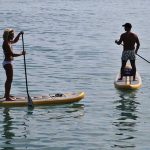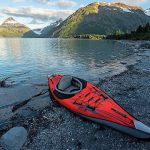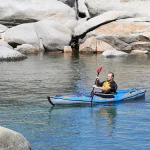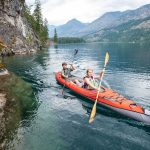If you’re just getting started with wakesurfing, one of the most important things to consider is what board is best for you. With so many different options on the market, it can be tough to decide which one is right for you.
Keep in mind that you’ll probably be spending a few hundred dollars on a board, so you want to make sure you’re going to love it.
Characteristics to consider
Wakesurfing is growing rapidly as a sport across North America. The ability to experience the rush of surfing without having to live near the ocean has led to the sport’s increasing popularity.
Wakesurfing is safer than other watersports because the speeds are lower and wipeouts are milder. This is appealing to parents who might buy a boat for their family.
Length
Longer boards tend to be better for beginners because they make it easier to control your front-back weight distribution. This makes it easier to catch the wave and move to different positions along with the wave. It also helps to prevent nose-diving, which is what spectators of wakesurfing live for.
However, even surfers who are not beginners may choose to use a longer board if they are taller and/or heavier.
The best wakesurf board to use for bigger surfers is almost certainly not going to be the best option for smaller surfers.
The stability of a longer board comes at the cost of being harder to carve. The larger turn radius makes it difficult to carve on the board.
Width
The width of the board can affect the board’s stability when going across latitudes. Wider boards make it easier to control your distribution of weight between the inside and outside of the board, as well as making it easier to get on the board because there is more surface area to push against the water.
Volume
The length and width of the board will usually determine how much water it can displace. The amount of water displacement will usually determine how buoyant the board is.
A board that is more buoyant will be easier to catch a wave with and stay on.
When choosing a surfboard, you should consider the weight of the person who will be using it. A more voluminous board will be better for a bigger, heavier surfer.
When shopping online, look for a size guide that will help you determine the right size for your surfer based on their weight.
Fins
The fins on a surfboard have two primary functions. The first is to control the direction of the board. Larger fins will keep the board going straighter, making turns easier.
With smaller fins, you’ll have to use the sides of the board to carve, which is more difficult.
Fins on a surfboard prevent it from slipping out from under the surfer when carving.
Wakesurf board fin setups
Single fin
The type of fin setup typically seen on skim-style boards, which consists of one small fin in the rear, provides stability, hold and control, but can also break free easily for spins and lipslides. Such setups are more slippery than those with larger single fins, but are a whole lot of fun once you get the hang of them!
They are best suited for medium-large-sized waves.
Twin fin
The best way to describe this board is that it’s a lot of fun to ride. It has enough hold to allow you to do some nice turns, but it’s also easy to spin around 360 degrees. Many surf/hybrid style boards come with only two fins, but most boards have three fin boxes.
We really like riding SoulCraft surfboards with a twin fin setup. They’re not only stable and easy to ride, but they also carve really well and can generate some great slashes. You can also remove the center tail fin and ride the board as a twin fin.
It performs extremely well in waves of all sizes. Having two fins will make it much more stable than having just one fin, while also giving you a bit more push in the wave.
Thruster
The thruster fin setup, which includes three fins, is the most popular for good reason. The side fins help generate speed and the center fin offers stability and control.
This tried and true fin setup is awesome for anyone who wants more speed and stability for their riding. The center fin is usually smaller than the two side fins while also being perfectly symmetrical. In a versatile setup, the fins can be removed to ride it as a single or twin fin as well.
This setup excels in waves of all shapes and sizes.
Quad fin
The quad fin setup can only be found on surf-style boards. This setup is all about speed, and it allows the wakesurfer to pump and generate speed using the fins.
You can also take out two of the four fins to ride it as a twin fin too. This setup rides great on bigger-sized waves.
Wakesurf board tail styles
The most common tail shape on surfboards is a bigger, wider tail that is easier to catch the wave on and provides more “push” fordropping the rope and surfing the wave.
The extra “push” from a square or big, rounded tail typically results in quicker acceleration and increased overall speed. This is a fantastic option for those that don’t have a huge wave behind their boat.
Rounder tails are more responsive to turning and have a looser, more playful feel. Skim style boards have smaller, more pointed round tails that are ideal for spins and tricks. Round tails are great for medium-large-sized waves as they don’t have the same “push” as a big, square tail shape.
The fish tail shape has been popular in surfing for many years and is now appearing on more wakesurf boards.
The fish tail is wider than other tails, which gives it good push while still being responsive in turns. This makes it a good choice for smaller waves that don’t have a lot of power.
Wakesurf board rail styles
The rail of a wakesurf board affects the flow of water past the board, which in turn affects how the board rides and turns. A thinner, sharper rail will generate more speed and responsiveness, while a thicker, more round rail will give the board a more stable, consistent feel.
Below, you can learn more about each type of rail and which one is the best fit for you.
Full rail
A full rail is usually found on surf-style boards and is very stable and consistent, making it easy for riders of all ability levels to stay in the wave’s “sweet spot” and sustain speed.
Hard rail
The hard rail is found on most skim-style boards. The harder edge cuts through the water more easily, increasing board speed, and it breaks free more easily for spins.
However, it doesn’t have the same grip as a softer, fuller rail, so it feels more loose and slippery while surfing.
Blended rail
A blended rail is a type of surfboard rail that is somewhere between a full rail and a hard rail design. This type of rail is found on many of the hybrid-style boards.
A blended rail is a good universal option that is stable and user-friendly but playful enough to spin the board for 360s.
Wakesurf ropes and handles
A dedicated wakesurfing rope and handle are essential for safety. The ropes are usually about 25 feet long, which is just the right length for positioning yourself in the optimal part of the wave.
The handles are smaller than standard because you don’t need both hands at wakesurfing speeds, and this also reduces the risk of the rope getting wrapped around your arms, legs, or neck.
Additionally, the smaller size makes it easier to throw the handle back into the boat when you’re done surfing.
The three main factors to consider when choosing a wakesurf rope and handle are the length of the rope, the handle type, and the color/style.
Best wakesurf boards for beginners
If you have some surfers who are just starting out with wakesurfing, you need a board that is easy to stand on, easy to catch the wave on, and very stable.
This means you should get a Surf-style board with a lot of volume.
We wouldn’t recommend spending a lot of money on a Surf style board since it will likely take a beating from all the wipe-outs and mishaps. Here are some good examples of boards that would fit the mold:
- Hyperlite Landlock
- Liquid Force Rocket
- Ronix Koal Surface Crossover
- Liquid Force Rocket
As your surfers’ skill level increases, they may want to give a Hybrid board a try.
Best wakesurf boards for intermediate surfers
Once you’ve gotten the hang of getting up on the waves and keeping your balance, you’ll want to move on to more advanced techniques like carving.
Intermediate surfers should look for a board with a smaller turning radius for more agility. Here are some great Hybrid board options:
- Lib Tech Fly Pad
- Doomswell Nubstep
- Jetpilot Flying Dutchman
If you’re looking for a board to help you with buttery moves or just one that will let you watch some epic banana peel wipeouts, these two boards are a great way to get started in the world of Skim boarding.
- Ronix Carbon Air
- Liquid Force Reign
Best wakesurf boards for advanced surfers
You have figured out how to carve and now you want to be the best surfer on the lake. You deserve congratulations for your accomplishment!
If you have an advanced skateboard, you will be less stable, more responsive, and more likely to do tricks like the one in the video.
There are some great options for advanced boards if you want a hybrid or skim style.
- Jetpilot Dylan Ayala Pro
- Hyperlite Transistor
- Liquid Force Keen
- Hyperlite Frother
- Hyperlite Wingman
Best Wakesurf Boards for Kids
The best wakesurf boards for kids are less voluminous than adult boards and are made of more durable, less expensive materials.
Here are some options for the little shredders in your boat:
- Ronix Super Sonic Space Odyssey
- Ronix Flyweight
- Liquid Force Gromi
- The Three Board Quiver
Conclusion
There is no one perfect wakesurf board. A hybrid board that is buoyant enough for beginners but still enjoyable for intermediate and advanced riders is probably the best option.
If you want to be prepared for every eventuality, it’s best to have a quiver of three boards: a Surf, a Skim, and a Hybrid.
That way you’ll have a board for beginner friends and family, an option for the intermediate surfer who wants to carve, and an option for the advanced surfer who wants to do tricks.
You don’t need to buy an intermediate or advanced board until your skills are ready for them. It’s best to buy three-board quivers as you and your surfers’ abilities require them.



